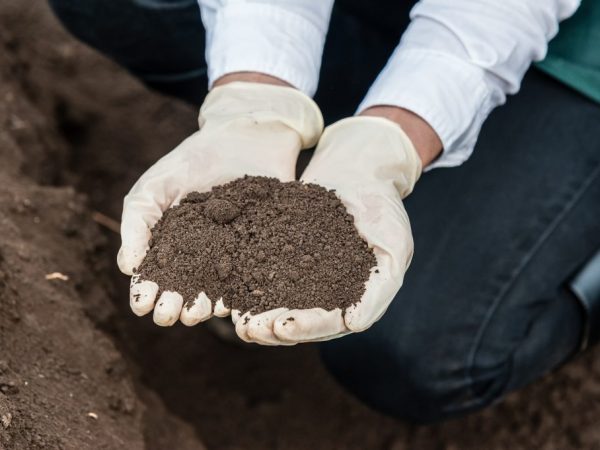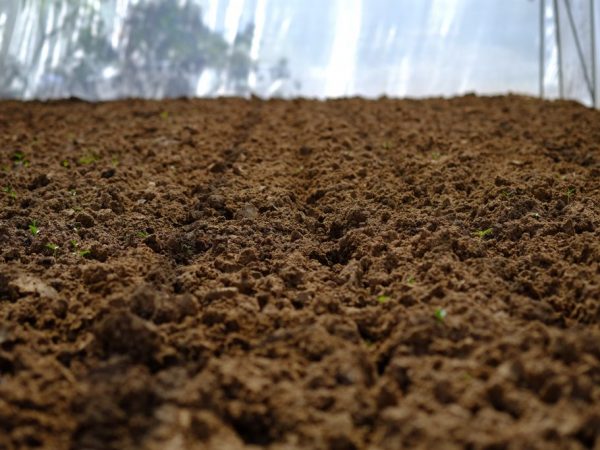Preparation of soil mixtures and soil in the greenhouse for tomatoes
Preparing the soil in a greenhouse for tomatoes is the key to a successful harvest. In the article, we will consider in detail all stages of preparation.

Preparation of soil mixtures and soil in the greenhouse for tomatoes
Seedling soil
For seedlings, land on which nothing has been grown for the last 3 years is perfect. The only harmless plant is nettle. If there is no such land, you can use soil from the beds. It is allowed that such cultures previously grew there:
- zucchini;
- carrot;
- cabbage;
- pumpkin.
It is important that these plants should not be sick with late blight. Otherwise, the soil must be neutralized or not used at all.
Due to its rich composition, forest land can be used. The best solution is to make the seedling soil yourself. To do this, you need to prepare peat, sod land. Another option is peat, sawdust, mullein.
For 5 kg of such a mixture, 1 kg of river sand, 5 g of ammonium nitrate, 1 g of superphosphate and 1 g of sodium chloride are needed. Before planting seeds or seedlings, the soil is steamed. It is recommended to disinfect it with a manganese solution.
Tatiana Orlova (Candidate of Agricultural Sciences):
Not all forest land is suitable for creating nutritious soil. A good soil composition is obtained from land taken from deciduous (but not coniferous) forests. Land taken in oak groves is not suitable, because fallen leaves contain a lot of tannins.
A good component of greenhouse soil is self-made compost or leafy soil obtained from the fallen leaves of fruit trees in your garden.
Soil selection
The ground should be warm, warm and easy to let air through.
Recommendations to follow when selecting soil:
- Fertility. The soil for tomatoes in the greenhouse must contain enough nutrients. In the future, their number is replenished with the help of fertilizers.
- Balance. All soil components must be in optimal proportions. An overestimated or underestimated concentration of a substance will negatively affect the fruits.
- Air and moisture permeability. Tomatoes love loose and porous soil. Also, there should be no plant debris in it.
- Lack of pests. The soil for tomatoes in the greenhouse should not contain pathogenic microbes, fungal spores, larvae and other pests. They will destroy young shoots and the bush will not be able to continue its development and growth.
- Purity. The greenhouse land allocated for tomatoes must be free of heavy metals; if it contains industrial waste, the likelihood of a good harvest is low.
The normal pH level for growing tomatoes is 6.5-7. It is important that the soil in the greenhouse prepared for tomatoes retains moisture well.
A prerequisite is the presence of vermicompost. It is an organic compound obtained after the processing of organic components by worms. The composition includes manure, straw, leaves, silage residues, hay, bird droppings.
Tatiana Orlova (Candidate of Agricultural Sciences):
In every town, you can buy a box of red Californian worms in a fishing shop in the spring. Their fertility and productivity in processing plant residues are many times higher than the productivity of ordinary earthworms. By running Californian worms into the compost heap in the spring, you will get ready-made vermicompost by autumn.
Training
To get a high-quality harvest, you need to take care of the soil all seasons - autumn, spring and winter. The garden bed requires special care at every stage.
Autumn

Fertilizing the soil is important
Preparing the soil in the greenhouse in the fall for tomatoes is an integral part of growing tomatoes. It is necessary to remove all weeds, leaves and old plants from the ground. The next step is to remove a 6-7 cm layer of soil. The main pests live in it.
An important procedure is the main fertilization. It is necessary to nourish the future beds with organic matter. To do this, in the fall, take cow dung and fresh infusion of bird droppings. An alternative is green manure or green manure. The following plants are suitable:
- lentils;
- radish;
- clover;
- oats;
- buckwheat;
- soy;
- peas, etc.
They need to be sown in the fall. Withstand until the flowering period and dig up. This can be done in spring, but then the green fertilizer will be 2 times less.
Tatiana Orlova (Candidate of Agricultural Sciences):
The main (main) fertilization is carried out in the fall when digging the soil. It is called the main one because high doses of manure, compost or other organic matter and relatively high doses of mineral fertilizers - superphosphate (up to 150 g / sq.m) and potash fertilizers (up to 100 g / sq.m) are introduced for autumn digging - these are two one third of the annual need of plants for these substances. And nitrogen and 1/3 of phosphorus and potash fertilizers - in the spring in podkomkah.
Winter
In early to mid-January, snow can be applied to the greenhouse. If this is not done, the soil for the tomatoes will dry out completely and will be unsuitable for growing a vegetable. Without snow, the soil becomes dry and dusty.
It is important to regularly dig up such beds so that the snow is evenly distributed. Then they are leveled and green manure is planted.
If you plan to plant winter varieties of tomatoes, you can install waterproofing on the ground and on the sides of the garden. Next, a non-woven fabric is lined, where a layer of sand 3 cm thick is poured. A heating cable is laid on top and again a layer of sand.
Spring
After winter, the soil must be thoroughly loosened. After that, it will be breathable.
The soil is dug up with ash and perlite. This will help maintain the proper level of water balance.
Top dressing is important in the spring. The best one is based on organic components. Many experts advise planting earthworms in the soil for tomatoes in a greenhouse. They process different substances into active biomass. 7 worms are enough for 1 m2.
They are placed in pre-dug holes, which are then sprinkled with earth. After the procedure, be sure to water the ground with a little water.
Creating warm beds
When 3-4 leaves appear on the seedlings, it can be transplanted into the greenhouse soil for tomatoes. The temperature should be at least 15 ° C so that the root system does not rot.
You need to dig holes for the seedling bushes. Pour hot water or boiling water over the wells. After that, cover the bed with foil for an hour. After this time, the seedlings can be planted. This method is also suitable if the tomatoes are to be planted outdoors.
Warm beds are formed in the fall. The procedure is as follows:
- Remove a layer of earth 15-20 cm thick.
- At the bottom, lay mulch from sawdust, coniferous branches, straw.
- Cover the mixture with quicklime. Layer height - 7 cm.
- A layer of cow dung 10 cm thick is placed on top.
- A soil mixture is made from 3 kg of wood ash, 1 kg of ammonium nitrate, 3 kg of superphosphate. This is enough for 4 m2 of soil. The soil mixture is poured onto the previous layers and compacted.
- In the spring in the greenhouse, the soil for tomatoes is cleared of weeds.
Another popular method is the "puff pie". The soil layer is removed in early spring. The bottom layer must be covered with pebbles and branches. Place a mixture of 200 g of urea on top. Mix this amount of fertilizer with 3 buckets of sawdust.
The next layer is quicklime. To do this, mix the land where tomatoes, mineral fertilizers and ash will grow. Alternate a layer of quicklime and sawdust twice.
Conclusion
Preparing the soil for planting tomatoes in a greenhouse is an important step in growing this vegetable crop. The yield depends on the correct choice of soil. It is better to cook new soil than to use one in which other vegetables have grown in advance.



